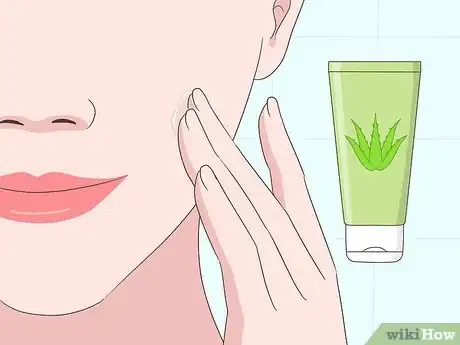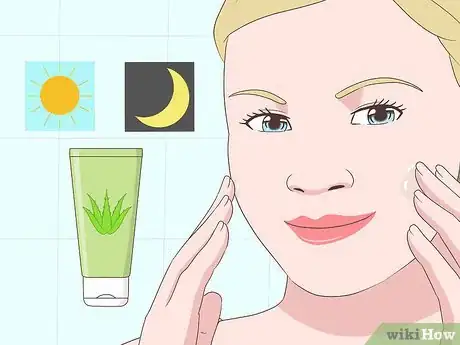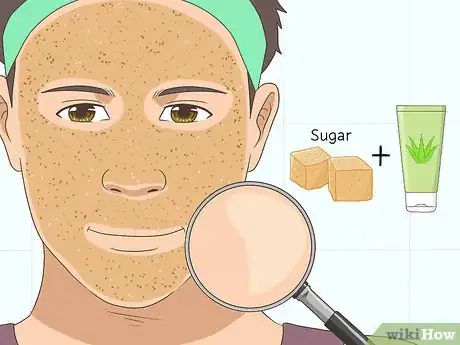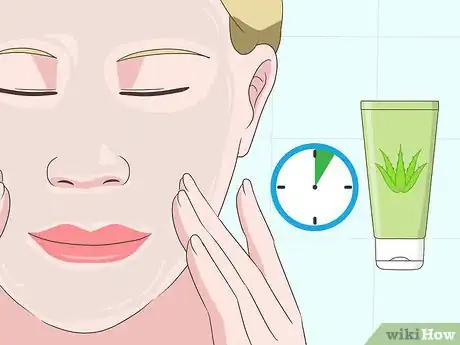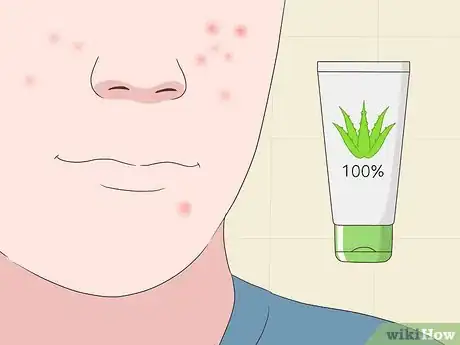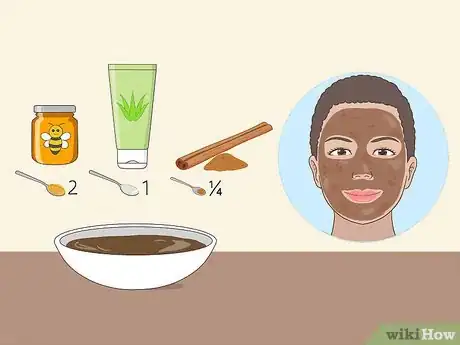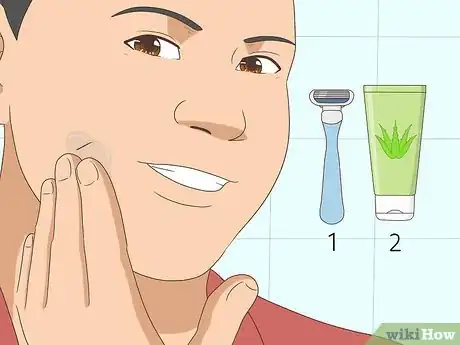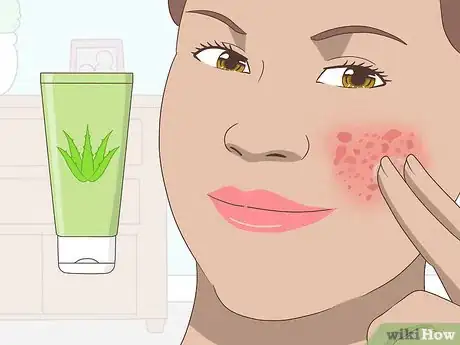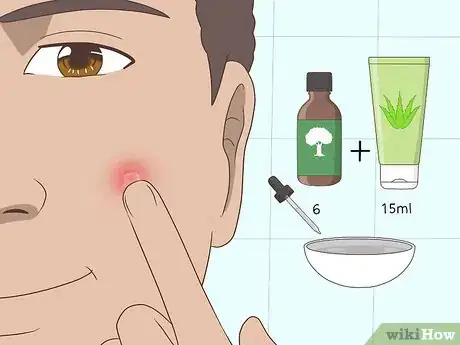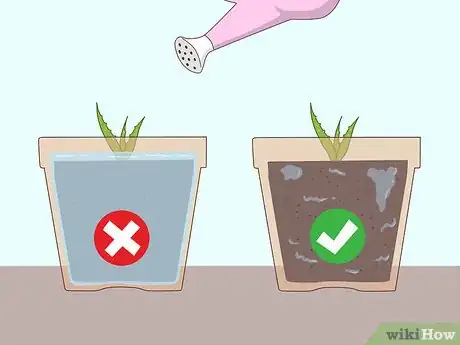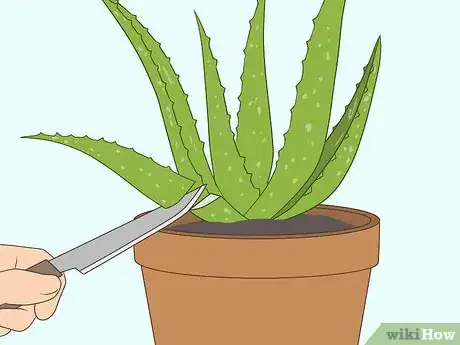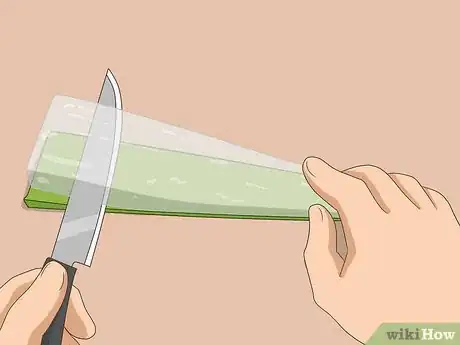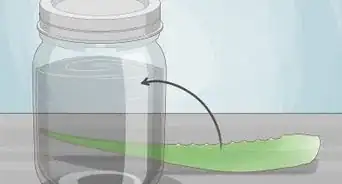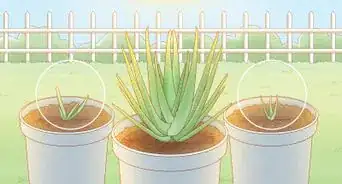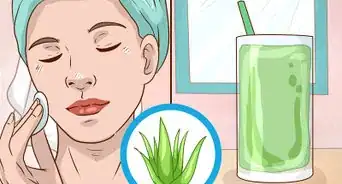This article was co-authored by Ritu Thakur, MA and by wikiHow staff writer, Jennifer Mueller, JD. Ritu Thakur is a healthcare consultant in Delhi, India, with over 10 years of experience in Ayurveda, Naturopathy, Yoga, and Holistic Care. She received her Bachelor Degree in Medicine (BAMS) in 2009 from BU University, Bhopal followed by her Master's in Health Care in 2011 from Apollo Institute of Health Care Management, Hyderabad.
There are 9 references cited in this article, which can be found at the bottom of the page.
wikiHow marks an article as reader-approved once it receives enough positive feedback. In this case, 93% of readers who voted found the article helpful, earning it our reader-approved status.
This article has been viewed 702,477 times.
The antiviral and anti-bacterial properties of aloe vera gel offer many benefits for your skin – especially the delicate skin on your face and neck. While aloe vera is an ingredient in many beauty products, you can also use pure aloe vera gel directly on your face. Applied properly, the gel helps moisturize your skin to smooth fine lines and wrinkles. It can also be used to reduce the appearance of acne breakouts.[1]
Steps
Moisturizing Your Skin
-
1Apply aloe vera gel gently with your fingertips. To get the full benefit of aloe vera gel on your face, dab it lightly. There's no need to deeply massage it into your face. If the gel is absorbed too deeply, it could have the opposite effect and cause your face to dry out.[2]
- Only use a thin layer of the gel. There's no need to slather it on. An extra thick layer won't provide any added benefits.
- For best results, leave the aloe vera gel on your face for about 10 minutes, then rinse your face with cool water and pat dry. Pure aloe vera gel may have a drying effect if you leave it on your skin for too long.
-
2Cleanse your face with aloe vera gel twice a day. Aloe vera gel can take the place of both facial cleansers and moisturizers when used correctly. In the morning and the evening, apply a thin layer to your skin. Rinse off with cool water and pat your face dry.
- Avoid rubbing the skin on your face, especially the delicate skin around your eyes. This can damage and weaken your skin.
Advertisement -
3Create a moisturizing facial scrub to moisturize oily skin. If your skin is oily and acne-prone, you may find that traditional moisturizers only worsen your skin's tendency to break out. Combine brown sugar and aloe vera gel for a potent scrub that gently removes dead skin cells that can clog your pores, while also giving your skin healthy moisture.
- To make this scrub, pour a small amount of brown sugar into the palm of your hand. Add aloe vera gel into all of the sugar is well-moistened.
- Spread the mixture evenly over your whole face, avoiding the delicate skin directly around your eyes. Massage gently for 1 to 2 minutes, then rinse off with cool water and pat your skin dry.
- Use this scrub at least twice a week, or as needed. Discontinue if your skin becomes excessively oily.
-
4Use aloe vera gel in moderation to get the most benefit. Aloe vera gel can help moisturize your skin and improve your skin's overall tone. However, because the enzymes in the gel act as exfoliators, frequent use can actually dry out your skin.
- Skin produces oil when it gets too dry. If you use aloe vera gel too frequently, you can send your oil production into overdrive. This can lead to clogged pores, inflammation, and acne breakouts.
- If you're just starting to use aloe vera gel on your skin, rinse it off immediately or leave it on for no longer than 10 minutes.
Tip: If you want to leave aloe vera gel on your skin for a longer period of time, or overnight, dilute it with another moisturizing liquid, such as olive oil.
Treating Inflammation
-
1Use pure aloe vera gel to prevent acne breakouts. Pure aloe vera gel has antibacterial and antioxidant properties, so it can be used instead of a traditional facial cleanser. Because it also has anti-inflammatory properties, it is gentle and safe for sensitive skin. Trade your regular facial cleanser for aloe vera gel for at least a week to see if you notice any difference.[3]
- The enzymes in aloe vera gel also gently exfoliate your skin, removing dead skin cells that can clog your pores, leading to additional breakouts. This can brighten your skin, giving you a healthy glow.
-
2Make a face mask with aloe vera, cinnamon, and honey. Mix 2 tablespoons (43 grams) of honey, 1 tablespoon (21.5 grams) of aloe vera gel, and 1/4 teaspoon (1 gram) of cinnamon in a small bowl. Apply the mixture to your face, avoiding the delicate skin around your eyes. Leave the mask on for 10 minutes, then rinse.[4]
- Because both honey and cinnamon have anti-inflammatory and anti-bacterial properties similar to aloe vera, the mask may have increased benefits compared to using aloe vera gel alone.
Variation: Mix equal parts aloe vera gel and lemon juice. Apply a thin layer of this mixture to your face and leave it on overnight. In the morning, wash your face as usual. This treatment may help heal existing breakouts as well as prevent additional pimples from forming.
-
3Rub aloe vera gel into skin after shaving. If you shave your face, you may be left with tiny cuts in your skin that can burn and itch. Instead of using a commercial aftershave that can excessively dry out your skin, apply a thin layer of aloe vera gel.[5]
- Scratching tiny cuts can introduce bacteria into your skin, leading to additional inflammation. Aloe vera gel soothes your skin and makes it less itchy, so you'll be less prone to scratching.
-
4Apply aloe vera gel to existing breakouts to reduce inflammation. Because aloe vera gel has anti-inflammatory properties, it can reduce redness and swelling, making breakouts less noticeable. Its moisturizing properties also make it beneficial for many skin conditions, including eczema and rosacea.[6]
- If you are currently using a prescription medication to treat a skin condition such as acne or eczema, talk to your dermatologist before you start using aloe vera gel or stop using any prescribed treatments.
-
5Combine aloe vera gel with tea tree oil to increase acne-fighting benefits. Mix 6 to 12 drops of tea tree oil for every 15 millilitres (0.51 fl oz) of aloe vera gel. Start with 6 drops, and gradually increase as long as the mixture doesn't cause redness or irritation. Use this mixture as a spot treatment after washing and drying your face to heal smaller pimples.
- You can buy tea tree oil online or in a local health and beauty store. The amount of tea tree oil you can use depends on how diluted the tea tree oil is that you buy.
- Store any unused mixture in an amber-colored, air-tight glass container. Keep the container in a cool, dark place.
- If you spread it over your entire face, the treatment may help prevent new pimples from forming. However, you shouldn't use it as a substitute for other treatments without first consulting a dermatologist.
- Please be careful not to swallow the mixture - tea tree oil can have severe negative effects when swallowed. [7]
Harvesting Aloe Vera Gel
-
1Choose the correct aloe species. There are many different species of aloe plants, only one of which is called aloe vera. Other species are frequently grown as ornamentals because they are relatively easy to care for. However, you can only harvest aloe vera gel from an aloe vera plant, not from any of the other varieties. In a nursery, check the tag to determine the species of the plant.[8]
- True aloe vera plants are not particularly ornamental compared to other aloe plants, and seldom bloom when housed indoors.
- An aloe vera plant has thin leaves that are pale green and heavily spotted.
-
2Use cactus soil potting mix in a medium to large planter. A medium or large planter will give your aloe vera plant enough room to grow since they like to spread out. Choose a planter with good drainage so the soil will stay appropriately dry.
- Look for a planter with a single large hole in the bottom to drain moisture. If there is standing water in the planter, your aloe vera won't grow.
-
3Place your plant where it will get plenty of light. Aloe vera plants can be tricky about sunlight. While they need plenty of sun, if they get too much, they'll dry out. Continual indirect sunlight typically provides ideal growing conditions.
- In the northern hemisphere, place an indoor plant in a window that faces either south or west.
- If the leaves of your aloe vera turn dry and brittle, this may be a sign that the plant is getting too much direct sunlight. Try relocating it and see if the plant's health improves.
-
4Avoid overwatering your plant to keep it healthy. The potting soil should be damp to the touch, but not wet. Examine the leaves of your plant to determine if it's getting enough water. As long as the leaves are cool and moist to the touch, your aloe vera is getting enough water.
- Generally, you shouldn't water your aloe vera until the soil actually feels dry to the touch. These plants typically don't need to be watered more than once a week. During colder months, they don't need as much water.
- If your aloe vera leaves are dry and brittle, consider how much sunlight the plant is getting before you give it more water – especially if the soil is still moist. Too much sunlight can cause the leaves to dry out.
-
5Cut thick, long leaves from the bottom of the plant. Using a sharp, clean knife or pair of scissors, snip off the leaves as close to the trunk of the plant as possible. Thicker leaves will have more aloe vera gel inside them.[9] Make sure that you only use healthy leaves![10]
- Do not attempt to harvest aloe vera gel from a plant that has dry, brittle leaves. Relocate the plant and wait until it has regained its health.
- You can harvest aloe vera gel from a healthy plant once every 6 to 8 weeks by removing 3 to 4 leaves from the plant.[11]
-
6Set the leaves upright to let them drain. Place the leaves with the cut side down in a glass or small bowl. After a few minutes, a red or yellowish liquid will begin to drain from the leaves. Allow the leaves to drain for 10 to 15 minutes.[12]
- This liquid is toxic and can cause stomach pain if ingested. Even if you're only planning on using the aloe vera gel topically on your face, it's still a good idea to let this liquid drain.
-
7Peel the outer layer of the aloe leaf. Using a clean, sharp knife, carefully slice away the spiky edges of the leaf. Then cut and lift the green part of the leaf away from the clear gel inside. It may take some practice, but you should be able to peel it away in a clean, smooth strip.
- Wash your hands before you begin this process. Work on a clean cutting surface to prevent contamination of your aloe vera gel.
-
8Scrape the gel out of the inside of the leaf. Once you have the gel exposed, slip your knife underneath the gel to separate it from the other side of the leaf. Go slowly, taking care not to knick into the leaf as you go.
- With practice, you may be able to harvest all the gel from a leaf in a smooth strip. However, it isn't necessary for the gel to be in a single piece. Multiple pieces work just as well and may be easier to handle.
-
9Refrigerate unused gel promptly. You can use harvested aloe vera gel on your face immediately. If you're harvesting it for later use, refrigerate it in an air-tight container. This will keep your aloe vera gel fresh.[13]
- Aloe vera gel degrades over time. You can keep it in the fridge for a few days up to a week. If you need to keep it any longer than that, freeze it.
You can also freeze aloe vera gel to make soothing aloe vera cubes. Put your aloe vera gel in a blender and pulse it 2 or 3 times until it is a smooth liquid. Pour it into ice cube trays and freeze. The aloe vera cubes can be placed directly on the skin for a cooling effect that soothes inflammation or irritation.
Expert Q&A
-
QuestionDoes aloe vera help with bruised skin?
 Ritu Thakur, MARitu Thakur is a healthcare consultant in Delhi, India, with over 10 years of experience in Ayurveda, Naturopathy, Yoga, and Holistic Care. She received her Bachelor Degree in Medicine (BAMS) in 2009 from BU University, Bhopal followed by her Master's in Health Care in 2011 from Apollo Institute of Health Care Management, Hyderabad.
Ritu Thakur, MARitu Thakur is a healthcare consultant in Delhi, India, with over 10 years of experience in Ayurveda, Naturopathy, Yoga, and Holistic Care. She received her Bachelor Degree in Medicine (BAMS) in 2009 from BU University, Bhopal followed by her Master's in Health Care in 2011 from Apollo Institute of Health Care Management, Hyderabad.
Natural Health Care Professional Yes, aloe vera will help with bruising. Other herbs that will reduce bruising include arnica, calendula, witch hazel, and turmeric root. All of these herbs are natural antiseptics that have anti-inflammatory and healing properties. Not only will aloe vera speed up how long it takes for your bruise to disappear, but it will also reduce pain and swelling.
Yes, aloe vera will help with bruising. Other herbs that will reduce bruising include arnica, calendula, witch hazel, and turmeric root. All of these herbs are natural antiseptics that have anti-inflammatory and healing properties. Not only will aloe vera speed up how long it takes for your bruise to disappear, but it will also reduce pain and swelling. -
QuestionHow do I make aloe face wash?
 Luba Lee, FNP-BC, MSLuba Lee, FNP-BC is a Board-Certified Family Nurse Practitioner (FNP) and educator in Tennessee with over a decade of clinical experience. Luba has certifications in Pediatric Advanced Life Support (PALS), Emergency Medicine, Advanced Cardiac Life Support (ACLS), Team Building, and Critical Care Nursing. She received her Master of Science in Nursing (MSN) from the University of Tennessee in 2006.
Luba Lee, FNP-BC, MSLuba Lee, FNP-BC is a Board-Certified Family Nurse Practitioner (FNP) and educator in Tennessee with over a decade of clinical experience. Luba has certifications in Pediatric Advanced Life Support (PALS), Emergency Medicine, Advanced Cardiac Life Support (ACLS), Team Building, and Critical Care Nursing. She received her Master of Science in Nursing (MSN) from the University of Tennessee in 2006.
Board-Certified Family Nurse Practitioner Method 1 of this article describes how to make an aloe face wash. You can also check out the information here: http://www.wikihow.com/Make-Natural-Face-Cleansers
Method 1 of this article describes how to make an aloe face wash. You can also check out the information here: http://www.wikihow.com/Make-Natural-Face-Cleansers
Warnings
- If you're buying aloe vera gel online or in a store, check the ingredients carefully. To get the full benefits of the product, do not buy aloe vera gel with any chemical additives.⧼thumbs_response⧽
- To keep your fresh aloe vera gel from going bad, always store it in an air-tight container in a cool, dry place.⧼thumbs_response⧽
References
- ↑ https://food.ndtv.com/beauty/6-amazing-benefits-aloe-vera-hair-skin-weight-loss-1221869
- ↑ https://www.medicalnewstoday.com/articles/322771.php
- ↑ https://www.medicalnewstoday.com/articles/321273.php
- ↑ https://www.medicalnewstoday.com/articles/321273.php
- ↑ https://www.mindbodygreen.com/0-7654/the-benefits-of-using-aloe-vera-for-skin-care-and-more.html
- ↑ https://www.medicalnewstoday.com/articles/321273.php
- ↑ https://www.nccih.nih.gov/health/tea-tree-oil
- ↑ https://davesgarden.com/guides/articles/view/3874
- ↑ https://learningherbs.com/remedies-recipes/freeze-aloe-vera-gel/
- ↑ Ritu Thakur, MA. Natural Health Care Professional. Expert Interview. 25 July 2019.
- ↑ https://www.ncbi.nlm.nih.gov/pmc/articles/PMC3551117/
- ↑ https://learningherbs.com/remedies-recipes/freeze-aloe-vera-gel/
- ↑ Ritu Thakur, MA. Natural Health Care Professional. Expert Interview. 25 July 2019.
About This Article
To use aloe vera gel on your face to moisturize your skin, use your fingertips to gently dab on a thin layer. After 10 minutes, rinse the gel off with cool water and pat your skin dry since leaving aloe on your skin for too long can actually have a drying effect. Since aloe vera gel has antibacterial and antioxidant properties, wash your face with it twice a day instead of other facial cleansers to prevent acne breakouts. Simply apply the aloe vera to your skin, then rinse it off with cool water. In order to tackle existing breakouts, apply some aloe vera to reduce the inflammation. If you shave your face, apply a thin layer of aloe vera gel after shaving to soothe irritated or scratched skin. To learn how to make an aloe vera facial mask, keep reading!
